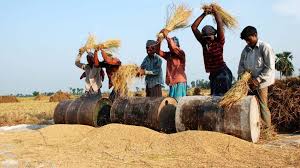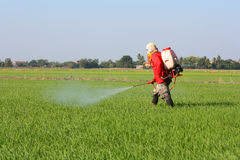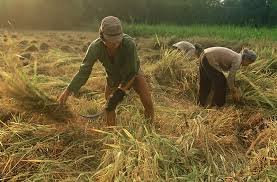BE A SUCCESSFUL RICE PRODUCER
Rice is one of the most consumable food crops in the world; it is reported to feed approximately half of the world’s population. It belong to the grass family.Rice is growing in a different soil types and water conditions such as irrigated, rain fed lowland, upland, and flood areas, depending on area where it is produced. Although there are many method of producing rice, but cultural practices are the same except the clear difference between swampy land and dry land cultivation.

source
First stage: Creating a crop calendar
A crop calendar is an archetype of your rice growing season right from land preparation to storage level. Adoption of crop calendar make the farm activities to be more easier, well planned, it make each activities to be performed one after the other and at the appropriate time, it also reduces the loss and it ensure efficient utilization of farm inputs such as seed,fertilizer etc.which reduce the input costs and increase yields because there will be no room for wastage.This calender should be place at where it can be seen time to time. Major content of the

[source](I designed it my self using power point then converted it to image)
How to use your cropping calendar
This calender should be place at where it can be seen time to time.
Pick the best date to plant.
Know the period that the selected variety takes from planting to harvest
Mark the planting date on the your designed cropping calendar and when anoother operation is to be carriedout.
Second Stage: Select the best seed variety or breed
The criterial for breed/Varieties selection should be based on good yield potential, tolerance and ability to disease resistance, custormers intrest should be considred, and high milling yield.
In determination of breed to be selected the following conditions can be put into consideration:
Duration of the crop: this need to be considered because different crop duration have their suitable areas and period in the season.
The crop height is also need to be considered because different area have different climatic/weather and soil condition.For instance growing tall variety in a area where there always be high wind blowing or a short variety in a water logged area are the examples of height incompatibility with the area.
Quality seed should be selected.
Seed dressing: Seed dressing is the application of chemicals such as pesticides, fungicides etc. to protect the seeds from being attacked by other organisms like pest, fungi etc.
Seed Germinating Test or Viability Test
Viability test is the process of subjecting seed to a particular test to verify if the seed is liable to germinate or not. Carrying out this test will make one how viable the selected seed is.
Third Stage: Land Preparation
Land Preparation involve all the activities carryout on the soil before sowing seed to make it suitable enough to accommodate the seed. This activity involve plowing, harrowing, bed preparation (both nursery and permanent bed,and manuring.
Nursery bed: A nursery bed is a part of land specialy made for growing seedlings. It serve as a temporary home for plants before they transferred to their permanent land.
How to prepare nursery bed
The nursery bed is prepared beds at wideness of 1m by length of your own convenient with the height of 5−10 cm
The seeds should be broadcasted in a shallow pool of water and leveled land.
The proper water path should be drawn for the exit of excess water.
Addition of organic manure (decomposed).
Seedlings should be transplanted at 15−21 days old. Spending more than that time at nursery will affect their growing at the permanent field. Nursery bed should be located closer to permanent bed.
How you can manage the weed
Weed is an unwanted plant at a particular time and place. Weed compete with plants in sharing space, soil nutrients and water, there is need to get rid of it. Weed can be managed by the following method
Good land preparation can reduce the weed emergence
First weeding should be carried out in 2–3 weeks when the transplanted seedling has recorvered from transplanting shock and is well established and the second weeding in another 5–6 weeks after transplanting.
Pre-emergence herbicide should applied after planting and before the establishment
Also post emergence herbicide should applied after seedling establishment
Before application of herbicides, weed should be correctly Identified and use the appropriate herbicides moderately as directed on the label. because inadequate quantity of herbicides will make weed to become tolerant to the herbicides used likewise excess is also hazardous to soil health.
Spray the field when the weed have not matured
Protective materials should be used while spraying
Application of fertilizer
Fertilizer is any material of natural (organic) or synthetic (inorganic) origin (other than liming materials) that is applied to soils or to plant tissues to supply one or more plant nutrients essential to the growth of the plants. The recommended fertilizer rate should be applied.
First dose of fertilizer should be applied 2-3 weeks after transplanting and Second dose should be applied at 7-10 weeks after transplanting. All Fertilizer application should be after weeding respectively.
Allow the water to drain to certain level before the application of fertilizer.
Harvesting
Paddy should be harvested when more than 70% of straw have become yellowish or brown and one should not allow it to dry completely because it will bring about wastage as a result of wind blowing. At least there should be moisture content of about 20-22%. The harvesting should take place at 13-16 weeks after transplanting.
To harvest, rice straw should be cut with sickle or knife, packed in bundles and should not be allowed to touch ground to avoid paddy wastage. The harvested straw should be dried before threshing.
Threshing is the removal of paddy from the rice straw. This could be done by beating the straw on hard surface or by using threshing machines.

source
Winnowing is the separation of chaff, foreign materials and empty grain from well-filled grains. The paddy should be well dried before storage.

source






